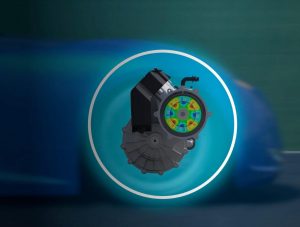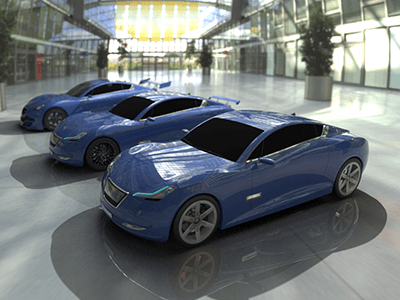6 Use Cases for CAE Simulation in Electric Vehicle Drivetrains
Simulation expedites the design and development process leading to higher performance electric vehicles.
As electric vehicles take over a larger share of the automotive market, OEMs and suppliers alike need to make use of every tool at their disposal to improve the performance of their vehicles. At present, no tool is more essential than CAE simulation when it comes to helping manufacturers test the design of EM components and how they contribute to the structure, efficiency, and performance of a vehicle.
While a lot of attention is often focused on battery performance in EVs, the electric drivetrain also presents completely new engineering challenges that require extensive simulation in order to understand how interconnecting systems affect each other. From our experience working in the automotive industry, we have identified six key areas where simulation helps EV engineers improve drivetrain performance. Let’s take a closer look.
1. NVH

Trust the Drive – Electric Drive Noise and Vibration Analysis
WATCH THE WEBINAR NOW
In automotive engineering, reducing NVH (noise, vibration, and harshness) is essential to providing a comfortable passenger experience. Combustion engines are significantly more noisy than electric motors, which might lead some to believe that NVH reduction doesn’t require the same level of care and attention. However, the noise of the combustion engine masks a lot of NVH issues that would otherwise be problematic. With the engine noise gone, passengers are more likely to notice outside noises, as well as sounds from the gearbox or coolant systems.The issues are similar for vibration. A vehicle that moves and shakes is disquieting to passengers, and gives an impression of low quality. While passengers expect vibration from a combustion engine, electric vehicles will still experience vibration conditions when they are on the road. These can be more noticeable to passengers, leading them to feel less satisfied with the vehicle.
These factors are what make NVH simulation in electric vehicles so important. CAE simulations can show how disparate parts work together to contribute to passenger experiences of NVH. These can then be remedied in the design.
2. Electric Motor Performance
Electric vehicles have typically lagged behind those with internal combustion engines (ICEs) in terms of power and performance. This has been a barrier to wider adoption, as improvements in motor and transmission performance have come at a tradeoff to battery longevity. However, newer EV technologies have increased the efficiency of electric powertrains, allowing them to compete with and even outperform their ICE counterparts.
Multiphysics simulations have been integral to these improvements, and can help automotive manufacturers develop even better designs. This can be particularly important in optimizing motor efficiencies with gear ratios, to improve performance on highways or during uphill driving.
3. Thermal Management

Electric Drive Engineering
WATCH THE WEBINAR NOW
Proper thermal management keeps components operating at optimal efficiency, which results in less drain on the battery and greater range for the vehicle. Thermal management systems in electric vehicles are more complex than their ICE counterparts, as batteries must be either cooled or heated depending on operating conditions, and because EMs don’t generate any waste heat that might be used to warm the cabin.Analyzing the way motors, inverters, generators, and batteries work together to consume energy is an important part of thermal management. Simulations can be used to model the entire vehicle to better integrate these systems for more efficient use.
4. Lubrication
Electric vehicles require different lubricants than ICEs. Without fossil fuels and with fewer moving parts, these systems run cleaner, meaning the engine oils will collect fewer contaminants over time from burning fuel. However, EV motors operate at very high speeds, and still require both oil and coolant. And, while EV transmissions are different from ICEs, they do still require lubrication for the gear reducer.
Thus far, there is no one solution to which lubricants should be used for different EV transmissions. While some manufacturers use traditional transmission fluid, others are relying on grease bearings with oil lubricants. CFD simulation can help engineers understand which lubricants work best based on their design choices.
5. New Materials

WLTP and Lightweighting – Lighten the Burden of WLTP
WATCH THE WEBINAR NOW
A key strategy for improving fuel efficiency in electric vehicles is to reduce the weight of the vehicle itself. Increased strength and stiffness can also improve the responsiveness and speed of electric motors, leading to better operating conditions. However, for a manufacturer to move from traditional metals to new, lightweight alloys, they must be able to ensure that these new materials can withstand the strains of use within an electric vehicle.CAE simulation can show how these new materials behave when used in EV driveline components, from the motor to the gearbox to the structural housing, so that manufacturers can continue to find new and more effective materials for their vehicle designs.
6. Durability
The reputations of automotive manufacturers are made or broken on the reliability and longevity of their products. Premature failure of components leads to lost trust among consumers, as well as extra expenses for manufacturers in case of a large recall.
Using CAE simulation, engineers can create models to run fatigue tests and predict failure conditions for every component in the EV driveline. These simulations can help manufacturers determine repair schedules and write better warrantees for their vehicles.
CATI can support your simulation needs for electric vehicle drivetrains.
CATI offers CAE simulation support for OEMs and suppliers in two key ways. First, we are value-added resellers (VARs) of Dassault Systèmes software, including Abaqus, CST Studio Suite, CATIA, and SIMULIA. For manufacturers who hope to expand their CAE departments we offer support for using this software to set up custom workflows.
Second, as CAE and FEA consultants, we bring our multidisciplinary expertise to the table, helping our clients find solutions to complex problems. We can perform CAE simulations for our clients, increasing the capabilities for those who do not have CAE engineers on staff, and expanding the capacity for those who need extra assistance during peak production times.
If you are looking for a CAE partner to help test designs for EV components, contact us. We would love an opportunity to contribute our automotive expertise to your project.

 Blog
Blog